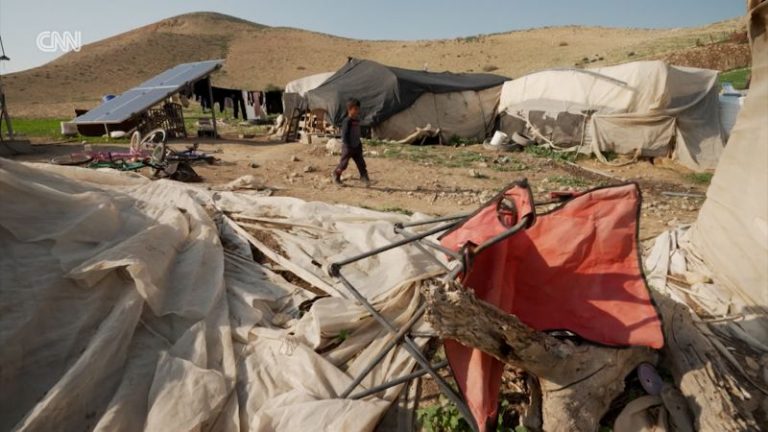Jihad Suleiman Al-Sawafta, 46, has lived on his farm in the occupied West Bank village of Bardala his entire life. But when Israeli settlers showed up in December, Al-Sawafta said his land, and his livelihood, shrank to a fraction of its former self.
“They crowded the area. They took thousands of dunams (1,000 square meters) from Bardala and its grazing lands,” he said, referring to his Palestinian town in the northern part of the West Bank. He added that the Jordan Valley, a fertile strip of land long considered the West Bank’s breadbasket, had been “largely emptied”of its Palestinian residents.
Herding outposts like the one set up on Al-Sawafta’s land are often established by Israeli settlers on hilltops with a few caravans and sometimes livestock to mark their claim. Monitoring groups say they are notorious for swallowing up vast swathes of land and prohibiting Palestinian residents from moving freely. The outposts are illegal under both Israeli and international law, and the state is not allowed to finance or build on them.
The number of Israeli herding outposts has dramatically increased since Israeli Prime Minister Benjamin Netanyahu’s far-right coalition took power in 2022 on a platform of settlement expansion. The government includes ministers who are themselves settlers and want to annex the occupied territory to Israel. In the wake of the Hamas-led attacks on October 7, 2023, which triggered Israel’s invasion of Gaza, settlers have accelerated land grabs with support from the state.
Peace Now and Kerem Navot estimate that shepherding outposts, occupied by a few hundred settlers, now cover almost 14% of the West Bank. Some of the unauthorized outposts are run by extremist Israeli settlers and settler groups that were sanctioned under the Biden administration, according to the monitoring groups.
Of the total land seized by settlers in the West Bank since the 1990s using herding outposts, 70% has been taken in the last two and half years alone, the report found.
‘Empowered to do whatever they want’
There is no official planning approval for outposts, unlike officially recognized Jewish settlements, which tend to be larger, more organized urban developments. Settlements are considered illegal under international law and by much of the international community, but Israel disputes that.
For Palestinians living near the outposts, their expansion in recent years has often meant losing access to their land and natural resources, as roads, fences, and settler activity gradually cut them off.
The land grabs have gone hand-in-hand with an escalation in violence by Israeli security forces and settlers against Palestinians living in the occupied West Bank.
Israel’s defense minister said at the end of February that he had instructed the military to “prevent the return of residents” who had been displaced by Israel’s military operations in four refugee camps in the northern part of the territory beginning January 21. The United Nations estimated that some 40,000 have been forced to flee their homes.
There are also mounting concerns among Palestinians that US President Donald Trump may endorse annexation of the occupied territory, which is home to more than 3 million Palestinians. “We’re discussing that with many of your representatives,” Trump said in a joint press conference with Netanyahu in Washington, DC, in February. “People do like the idea, but we haven’t taken a position on it yet.”
His proposal for Gaza to be emptied of its inhabitants and developed have raised alarm among rights groups and Palestinian communities, who worry a similar rhetoric could be applied to the occupied West Bank.
Israel seized the West Bank and East Jerusalem from Jordan in 1967. It annexed East Jerusalem, which is also considered occupied under international law, in 1980.
According to the report from Peace Now and Kerem Navot, more than 60 Palestinian shepherding communities have been forcibly displaced since July 2022 – the majority of these since October 7.
“The idea behind it is clear, it is to take the open areas in the West Bank to make sure Palestinians cannot access them, and eventually to hand them over to Israeli settlers.”
In July last year, the United Nations’ top court said Israel should end its decades-long occupation of the West Bank and East Jerusalem, evacuating settlers from the territories designated for a future Palestinian state and halting any new settlement activity. Israel’s foreign minister at the time rejected the non-binding ruling as “fundamentally wrong” and one-sided.
Despite outposts being illegal even under Israeli law, the Office of the UN High Commissioner for Human Rights has said there is a “consistent pattern of Israeli authorities’ involvement, assistance and financing of the construction of outposts, as well as their operation.”
Documents uncovered by Peace Now last year showed how the Israeli government has budgeted millions to protect the small, unauthorized farms. The monitoring group said the money paid for vehicles, drones, cameras, generators, electric gates, light poles, solar panels and fences.
The Israeli government approved 75 million shekels ($21 million) in December 2023 for providing security in the West Bank to what it called “young settlements.” Orit Strock, the Minister of Settlements and National Mission, told the Associated Press that the funds were coordinated with the Defense Ministry and “carried out in accordance with all laws.”
Israeli law affords the WZO semi-governmental status, giving it authority “for the development and settlement of the country.” The WZO’s Settlement Division, which describes itself as an “arm of the Israeli state” and is funded by Israeli public money, is responsible for managing the allocation of land to “form and strengthen the settlement of Jews in periphery areas, by increasing the hold on the lands of the country that were passed onto the division by the government of Israel,” according to its website.
Most of the land seized by settlers for illegal shepherding outposts is not classified as Israeli state land, according to mapping data from the Israeli Civil Administration analyzed by Peace Now and Kerem Navot. Nearly 60% of the land, around 470 square kilometers, is either privately owned by Palestinians, has unclear ownership, or falls within Palestinian Authority territory, the report said.
Daraghma said that settlers regularly chase away his sheep and terrorize the community’s children late into the night. “They threaten us that if we go up to this mountain there, they will come to us at night. They say, ‘If you go here, we will come to take your children,’” he said.
A few weeks later, he said his family was forced to flee.


